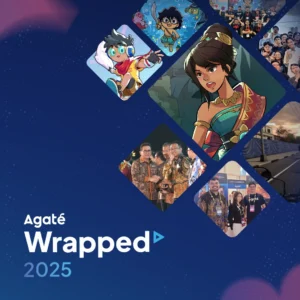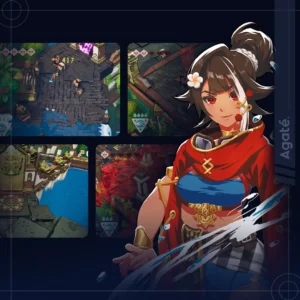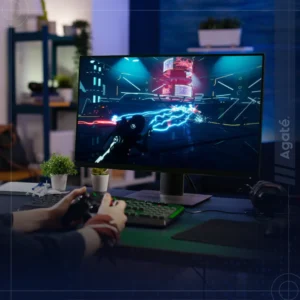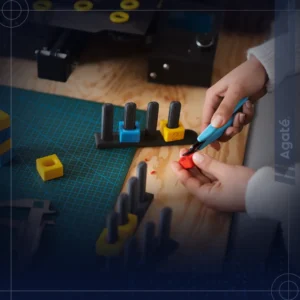Art is a profound expression of human creativity, serving as a powerful medium for communication, storytelling, and visual aesthetics. Across various forms of artistic expression, art is a diverse form of expression that encompasses traditional paintings and modern digital creations. Within art, different styles have emerged, each with its own characteristics and appeal. As artists showcase their work to the world, we can appreciate the variety of art styles. From Jacques Louis David’s Neoclassicism, Vincent Van Gogh’s Impressionism, to Salvador Dali’s Surrealism. Each art style is distinct and conveys a certain meaning in its work.
As the agile nature of technology continues to advance, so does the medium of art, which shifts from physical to digital. As computer technology began to generate shapes, colors, and functionality, art became more than just something we could see. It invites us to be a part of the art itself, hence the conversation on whether games are considered interactive art. And as time goes, there is also a rise in the art style of video games.
We will delve into some of the prominent art styles out there in video games, including realism, fantasy realism, low poly, hand-painted, cartoon, anime, and many other types of art styles, highlighting their features and exploring how they find their place in the dynamic world of video games.
The Foundation of Video Game Art Style
Gamers who often wonder about a game’s art style will undoubtedly appreciate the artists’ choice and decision behind it. But little do we know that that is only a part of it. This is because the truth is that a game developer’s art style or artistic decision is actually also confined to the technology available during the time they decide to build their game.
Unlike contemporary artists who find their art style from inspiration and idea that surrounds them. Video game artists get their art style from the availability of technology that they have. Historically speaking, there is evidently an evolution of game art if you consider the technological factor as well.
Although there are many advanced technologies available for creating video games today, not all artists or developers have equal access to them. However, just like the artists of the past, video game creators can express themselves in various art styles, whether in 2D or 3D. Both dimensions offer a rich diversity of artistic possibilities in video games. Let’s explore some of these art styles, shall we?
Types of Art Styles in Video Games
Essentially, there are three kinds of art styles; according to Mary Keo, an Information Technology graduate of Häme University of Applied Sciences, and Aki Järvinen, a game specialist and academic, there are three basic art styles in video games. They proposed this classification in their thesis Graphical Style in Video Games. The three art styles are Abstract, Stylized, and Realistic.
Abstract Art Style
The abstract game art style uses simple shapes and forms to create the game elements. The players at first must guess what each element does because they don’t look like anything familiar. However, as they play the game, they can figure out the role of each element. Keo defines an abstract game art style by these features:
- The game elements (such as the environment, characters, and objects) are made of geometric shapes and forms.
- The game elements don’t have a direct resemblance to anything.
This style was the first one to emerge in video games because the technology was limited, and the developers were experimenting. Järvinen calls this style abstractionism. A classic example of this style is Pong. In this game, the players control two vertical lines that act as paddles and try to hit a small circle that represents a ball. The game is very abstract because it only consists of two lines and a circle.
However, as games evolved, the art style became a choice of either giving a nostalgic feel or something that is intentional that gives an enjoyable feeling in the game itself. One example of a more recent game that uses this art style is Retrograde Arena, when Agate made its acquisition with the developer Freemergency back in 2021.
Stylized Art Style
Stylized or stylization is the process of applying a specific artistic style to a game’s graphics and visuals. In a stylized game art style, the appearance of all of its characters, objects, and the environment takes inspiration from caricatures ranging from cartoons, comics, and other similar mediums, by which Järvinen refers to this art style as caricaturism. A stylized art style can help create a distinctive mood, atmosphere, and identity for a game, as well as appeal to different audiences and preferences. It can also be influenced by various genres and media that have established their own visual conventions and aesthetics. Some of the popular visual conceptions in this art style are:
- Comics, manga, and anime: These styles are inspired by graphic novels, shows, and comic books. They often feature colorful, expressive, and exaggerated characters and environments with dynamic poses, angles, and effects. Comics, manga, and anime styles are widely used in modern online and mobile games that cater to fans of fantasy, action, and anime genres. One example of this specific art style is Agate’s Valthirian Arc series.
- Pixel art: Pixel art is a style that uses small dots or squares of color to create pixelated images. Pixel art was common in the early days of gaming when the hardware limitations restricted the resolution and color depth of the graphics. However, pixel art has also become a popular choice for modern games that want to evoke a nostalgic, retro, or minimalist feel.
- Low-poly: Low-poly is a style that uses 3D models that have a low number of polygons or faces. Low-poly models are often composed of simple geometric shapes like triangles or squares, which give them a flat or angular appearance. Low-poly style can be used to create stylized or abstract characters and environments that have a unique charm and simplicity. Low-poly style can also be combined with other techniques like lighting, shading, or textures to enhance the visuals.
- Indie: Indie is a broad term that refers to games that are developed by independent or small-scale developers who have more creative freedom and control over their projects. Indie games often feature experimental or innovative gameplay mechanics, narratives, or art styles that are not commonly seen in mainstream or commercial games. Indie style can also reflect the personal vision or expression of the artist or developer who created the game. Indie style can vary widely depending on the genre and platform of the game.
Realistic Art Style
With the advent of technology, video games have become a medium for interactive art, allowing players to immerse themselves in various art styles. The availability of different technologies has influenced the choices and decisions of video game developers when selecting an art style. However, despite varying access to advanced technologies, artists and developers can express themselves in diverse art styles, whether in 2D or 3D.
While the distinction between realistic and stylized art styles can sometimes be blurred, the key factors in defining a game as realistic involve the game elements closely resembling real-life and adhering to real-world physics. The world of art and video games continues to evolve, offering a rich tapestry of art styles that cater to different preferences, moods, and storytelling purposes. Whether through the simplicity of abstraction, the charm of stylization, or the pursuit of realism, art styles in video games enhance the visual experience and contribute to the overall appeal and uniqueness of each game.
Conclusion
The Realistic art style strives to depict subjects with a high level of accuracy and fidelity. It seeks to recreate the physical appearance of objects, people, or landscapes in a lifelike manner. This art style often prioritizes precise detailing, texture, and shading, aiming to create an illusion of reality. The advancement of technology has led to the development of more sophisticated games and, of course, the possibility of achieving this art style. This is why realistic art styles emerged in the ‘90s. This style featured games with realistic human characters and real depictions of objects and environments. Game artists in Agate has also begun to dive into this specific art style. Games with these styles set the stage for the high-quality AAA games we play today.
However, there is some debate about whether some games with a slight caricature style belong to the realistic game art style or not. Some might consider them stylized games. This is because they have fantastical elements in their settings and stories. To classify a game as realistic, two elements are usually required: Where the game elements look as close to real-life as possible, and the game elements move according to real-world physics.







